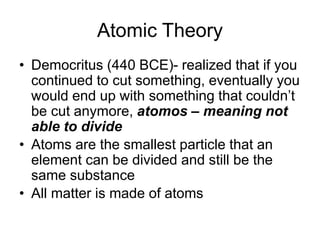
Atomic theory
- 1. Atomic Theory • Democritus (440 BCE)- realized that if you continued to cut something, eventually you would end up with something that couldn’t be cut anymore, atomos – meaning not able to divide • Atoms are the smallest particle that an element can be divided and still be the same substance • All matter is made of atoms
- 3. John Dalton (1803) • realized that atoms combine in very specific ratios based on mass • all substances are made of atoms and they can not be created, divided or destroyed because they were made of a single substance • All atoms of the same element are exactly alike and different from other elements, they are unique • Atoms join with other atoms to form new substance • Solid ball
- 5. J. J. Thomson (1897) • discovered that there were small particles inside the atom (electrons), meaning that atoms can be divided into smaller substances • Electrons – negatively charged particles attracted to positively charged particles • Plum pudding model – electrons are mixed throughout the atom, soft blobs of matter • Cathode ray tube experiment
- 8. Ernest Rutherford (1909) • Discovered that an atom contains a nucleus with positively charged particles and that the electrons must be “floating” around the nucleus • Most of an atom is empty space • Gold foil experiment
- 11. Niels Bohr (1913) • Proposed that electron moved around the nucleus in energy levels (shells), but no electrons between the energy level (think ladder) • Electrons can jump from one level to another • Travel in a definite path – solar system model
- 13. Modern Atomic Theory • Erwin Schrödinger & Werner Heisenberg • Electrons have no predictable pattern and move in a region where electrons are likely to be found called the electron cloud
- 16. Atoms • All atoms have a nucleus – protons (+), – neutrons (no charge: neutral) – electrons (-) • Same number of protons and electrons an atom has no charge • More protons (+) than electrons (-) the atom has a positive ion is formed (more positives than negatives) • More electrons (-) than protons (+) a negative ion is formed (more negatives than positives)
- 17. • 118 different element that are unique and all things known to exist come from a combination of these elements in specific mass ratios • Simplest atom is made of one proton, and 1 electron – hydrogen (has no neutrons)
- 18. • All additional elements will have protons, neutrons and electrons • The atomic number of an element is determined by the number of protons, – 1 is hydrogen, 6 is carbon, hydrogen has 1 proton, carbon has 6 protons (you can not change the number of protons) • To find neutrons take the mass number (rounded) and subtract the protons.
- 19. Isotopes • Isotopes have the same number of protons but additional neutrons which causes the atomic mass to be different • Isotopes can be stable (maintain their structure) and unstable (fall apart over time) • Unstable isotopes are radioactive and will decay over time giving off particles and energy (radioactive)
- 20. • Mass number determines the isotope, the number of protons and neutrons added together • Most elements have isotopes • All isotopes of an element have the exact properties of the element
- 21. Forces in atoms • Gravitational force – pulls objects toward each other—depends on mass and distances between the objects—very small force in atoms • Electromagnetic force –– proton (+) and electrons (-) have strong attraction which keeps the electrons in motion around the nucleus of atoms
- 22. • Strong force – force which keeps protons from flying apart due to close distance between protons and neutrons • Weak force – relevant to radioactive atoms- allows neutrons to change into proton and electron